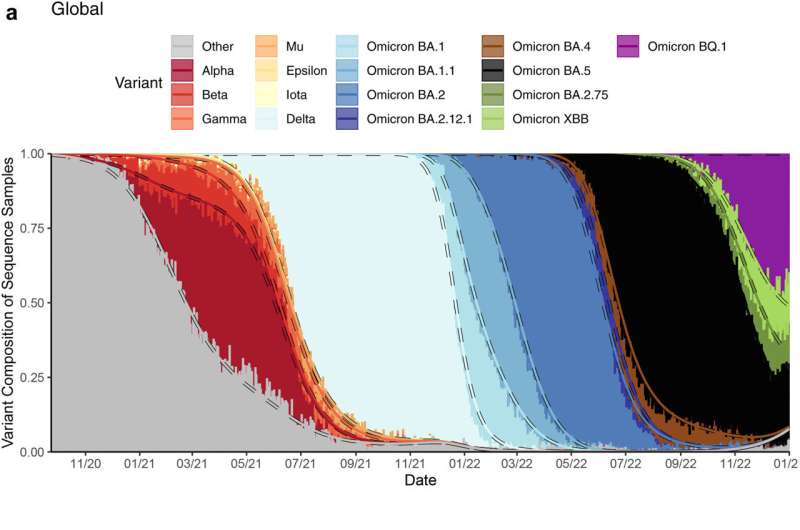This article has been reviewed according to Science X's editorial process and policies. Editors have highlighted the following attributes while ensuring the content's credibility:
fact-checked
peer-reviewed publication
trusted source
proofread
Research examines key factors related to COVID-19 variant dynamics

A team of researchers at Los Alamos National Laboratory recently published the most comprehensive study of global COVID-19 variant transitions, which showed significant diversity in variant spread around the globe related to vaccination rates, number of co-circulating variants and immunity from previous infection. The paper was published in eBioMedicine.
"This work pulls together a diverse set of data streams—demographic, clinical, behavioral and others—to really dig into what past variant transitions looked like globally," said Lauren Beesley VanDervort of the Laboratory's Statistical Sciences group and lead author on the paper. "It also helps identify possible explanations for why those transitions differed so substantially across the planet."
Since the first SARS-CoV-2 viral sequence became available in January 2020, there have been over 660 million confirmed cases of COVID-19 globally, leading to 6.7 million deaths. The virus continues to evolve, and global transitions to new variants can generate waves of disease spread.
"This study provides an integrated view of SARS-CoV-2 variant transitions, demonstrating that the factors contributing to the relative fitness of a new variant are complex," said Bette Korber of Los Alamos' Theoretical Biology and Biophysics group. "Both the speed of a transition and how complete it is depend on the SARS-CoV-2 infection history in the human population through which it is moving."
The research team looked at pandemic data to characterize differences in the speed, calendar timing and magnitude of 16 COVID-19 variant transitions for 230 countries and regions between October 2020 and January 2023. Using those data, they found that COVID-19 vaccines helped slow the speed of new variant transitions prior to the emergence of the delta variant. However, continuing viral evolution contributed to new waves of disease spread, with viral variants that have become progressively more infectious and resistant to protective antibodies.
The team also found that historical variant transition dynamics differed substantially between locations and were associated with vaccination rates, prior infection rates, the time since the last COVID-19 peak, population demographics and the number of co-circulating variants in competition with the emergent variant.
Specifically, they found that stronger immunity acquired from prior infection, due to higher prior infection rates and a shorter time since the last COVID-19 peak, was associated with later and lower peak-prevalence variant transitions relative to other countries. This suggests that new variant transitions may be slower in locations with a large recent disease outbreak.
While higher vaccination rates were associated with slower transitions prior to the delta and mu variants, delta and mu were key inflection points. Among omicron variants, that association was reduced, consistent with omicron's resistance to vaccine-created antibodies, which are a key aspect of protection from infection.
"This work may be able to inform modeling approaches that forecast how emerging variants may behave to mitigate their impact," said Sara Del Valle of Los Alamos' Information Systems and Modeling group.
More information: Lauren J. Beesley et al, SARS-CoV-2 variant transition dynamics are associated with vaccination rates, number of co-circulating variants, and convalescent immunity, eBioMedicine (2023). DOI: 10.1016/j.ebiom.2023.104534





















